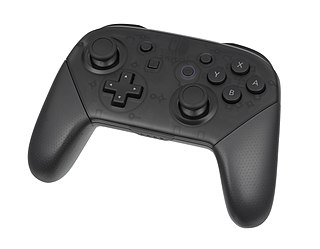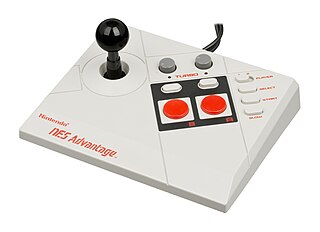
The Atari 7800 ProSystem, or simply the Atari 7800, is a home video game console officially released by Atari Corporation in 1986 as the successor to both the Atari 2600 and Atari 5200. It is able to run almost all Atari 2600 cartridges, making it the first console with built-in backward compatibility. It shipped with a different model of joystick from the 2600-standard CX40 and Pole Position II as the pack-in game. Most of the announced titles at launch were ports of 1980–83 arcade games.

A joystick is an input device consisting of a stick that pivots on a base and reports its angle or direction to the device it is controlling. A joystick, also known as the control column, is the principal control device in the cockpit of many civilian and military aircraft, either as a centre stick or side-stick. It often has supplementary switches to control various aspects of the aircraft's flight.

The Gravis PC GamePad is a game port game controller produced by Advanced Gravis Computer Technology first released in 1991. It was the first gamepad for the IBM PC compatible in a market then dominated by joysticks. Included with the gamepad was a shareware Commander Keen game, episode 1, Marooned on Mars, which was later replaced with the shareware episode 4, Secret of the Oracle which supported all 4 buttons. The gamepad is no longer manufactured, as Gravis was acquired in 1997 by Kensington Computer Products Group.

A game controller, gaming controller, or simply controller, is an input device used with video games or entertainment systems to provide input to a video game, typically to control an object or character in the game. Before the seventh generation of video game consoles, plugging in a controller into one of a console's controller ports were the primary means of using a game controller, although since then they have been replaced by wireless controllers, which do not require controller ports on the console but are battery-powered. USB game controllers could also be connected to a computer with a USB port. Input devices that have been classified as game controllers include keyboards, mouses, gamepads, joysticks, etc. Special purpose devices, such as steering wheels for driving games and light guns for shooting games, are also game controllers.

Microsoft SideWinder was the general name given to the family of digital game controllers developed by Microsoft for PCs. The line was first launched in 1995. Although intended only for use with Microsoft Windows, Microsoft SideWinder game controllers can also be used with macOS, Mac OS 9 with third-party software, and Linux.

The NES Advantage is an arcade style controller manufactured by Asciiware and released by Nintendo for the Nintendo Entertainment System in 1987. The device is meant to rest on a flat surface at a comfortable level, such as a tabletop or the floor, with the player seated behind it. This way, it could be used like an arcade game joystick—with the left hand using the joystick and the right hand operating the buttons.

A gamepad, joystick, controller, is a type of game controller held in two hands, where the fingers are used to provide input. They are typically the main input device for video game consoles.
The Jammer is an arcade-style controller for the Nintendo Entertainment System made by Beeshu. It is a clone of Nintendo's officially licensed arcade controller, the NES Advantage. On this controller, the turbo buttons are labeled "dial-a-speed" buttons. Beeshu also manufactured other controllers called the Superstick, Ultimate Superstick, Zipper, Zinger, and Zoomer.

A D-pad is a flat, usually thumb-operated, often digital, four-way directional control with one button on each point, found on nearly all modern video game console gamepads, game controllers, on the remote control units of some television and DVD players, and smart phones. Like early video game joysticks, the vast majority of D-pads are digital; in other words, only the directions provided on the D-pad buttons can be used, with no intermediate values. However, combinations of two directions do provide diagonals and many modern D-pads can be used to provide eight-directional input if appropriate.

An analog stick, sometimes called a control stick or thumbstick, is an input device for a controller that is used for two-dimensional input. An analog stick is a variation of a joystick, consisting of a protrusion from the controller; input is based on the position of this protrusion in relation to the default "center" position. While digital sticks rely on single electrical connections for movement, analog sticks use continuous electrical activity running through potentiometers to measure the exact position of the stick within its full range of motion. The analog stick has greatly overtaken the D-pad in both prominence and usage in console video games.

The V.Smile is a sixth-generation educational home video game console manufactured and released by VTech. Titles are available on ROM cartridges called "Smartridges", to play off the system's educational nature. The graphics are primarily sprite-based. The console is often sold bundled with a particular game, with most of them having a game called "Alphabet Park Adventure." Several variants of the V.Smile console are sold including handheld versions, or models with added functionality such as touch tablet integrated controllers or microphones. The V-Motion is a major variant with its own software lineup that includes motion sensitive controllers and has Smartriges designed to take advantage of motion-related "active learning". The V-Motion and Smartridges however are fully backwards compatible with other V.Smile variants and V.Smile Smartridges, and a V-Motion Smartridge can also be played on V.Smile console or handheld, albeit with limited functionality. However, in 2010, V.Smile NEW and OLD were canceled. VTech still made games for V.Smile Pocket and V.Motion.

Forgotten Worlds, titled Lost Worlds in Japan, is a side-scrolling shoot-'em-up game by Capcom originally released as a coin-operated video game in 1988. It is notable for being the first title released by Capcom for their CP System arcade game hardware.

The Nintendo 64 controller is the standard game controller for the Nintendo 64 home video game console. Manufactured and released by Nintendo on June 23, 1996 in Japan, in late 1996 in North America, and 1997 in Europe. It is the successor to the Super Nintendo controller and is designed in an "M" shape and features 10 buttons, one analog "Control Stick" and a directional pad.

The GameCube controller is the standard game controller for the GameCube home video game console, manufactured by Nintendo and launched in 2001. As the successor to the Nintendo 64 controller, it is the progression of Nintendo's controller design in numerous ways. The contentious M-shaped design of its predecessor was replaced with a more conventional handlebar style controller shape; a second analog stick was added, replacing the C buttons with a C stick and the X and Y face buttons, last seen on the Super Nintendo controller, were reintroduced; the shoulder buttons were changed to hybrid analog triggers. A wireless variant of the GameCube controller known as the WaveBird was released in 2002.
Beeshu, Inc. was a video game accessory manufacturer headquartered in the United States. They primarily made products for the Nintendo Entertainment System, and also released a few accessories for Sega and Atari products. The company filed for bankruptcy in 1995.

The Atari joystick port is a computer port used to connect various gaming controllers to game console and home computer systems in the 1970s to the 1990s. It was originally introduced on the Atari 2600 in 1977 and then used on the Atari 400 and 800 in 1979. It went cross-platform with the Commodore VIC-20 of 1981, and was then used on many following machines from both companies, as well as a growing list of 3rd party machines like the MSX platform and various Sega consoles.

The Atari CX40 single-button digital joystick was the first widely used cross-platform game controller. The original CX10 was released with the Atari Video Computer System in 1977 and became the primary input device for most games on the platform. The CX10 was replaced after a year by the simpler and less expensive CX40. The addition of the Atari joystick port to other platforms cemented its popularity. It was the standard for the Atari 8-bit family of home computers and was compatible with the VIC-20, Commodore 64 and 128, MSX, and later the Atari ST and Amiga. Third-party adapters allowed it to be used on other systems, such as the Apple II and the ZX Spectrum.

Joy-Con are the primary game controllers for the Nintendo Switch video game console. They consist of two individual units, each containing an analog stick and an array of buttons. They can be used while attached to the main Nintendo Switch console unit, or detached and used wirelessly; when detached, a pair of Joy-Con can be used by a single player, or divided between two as individual controllers.
















